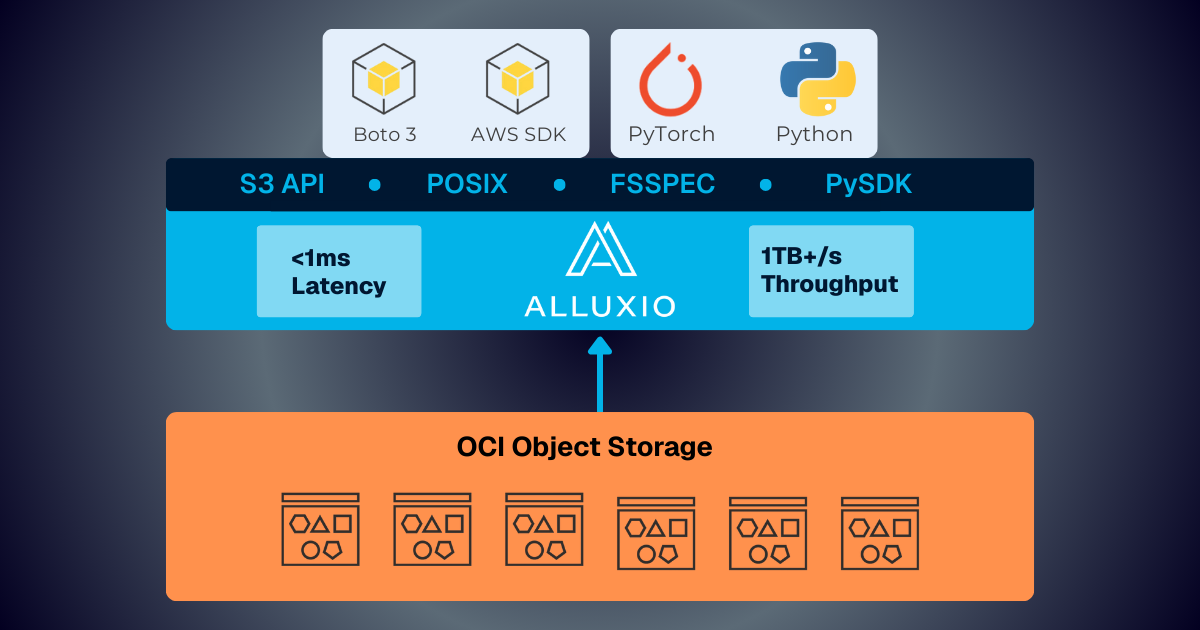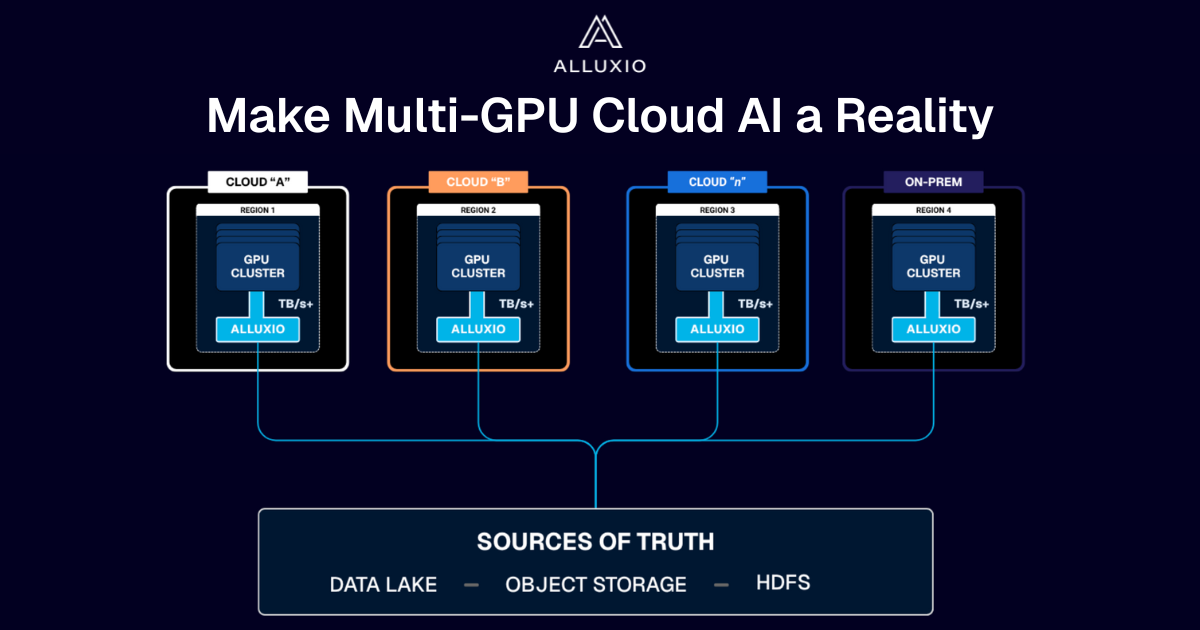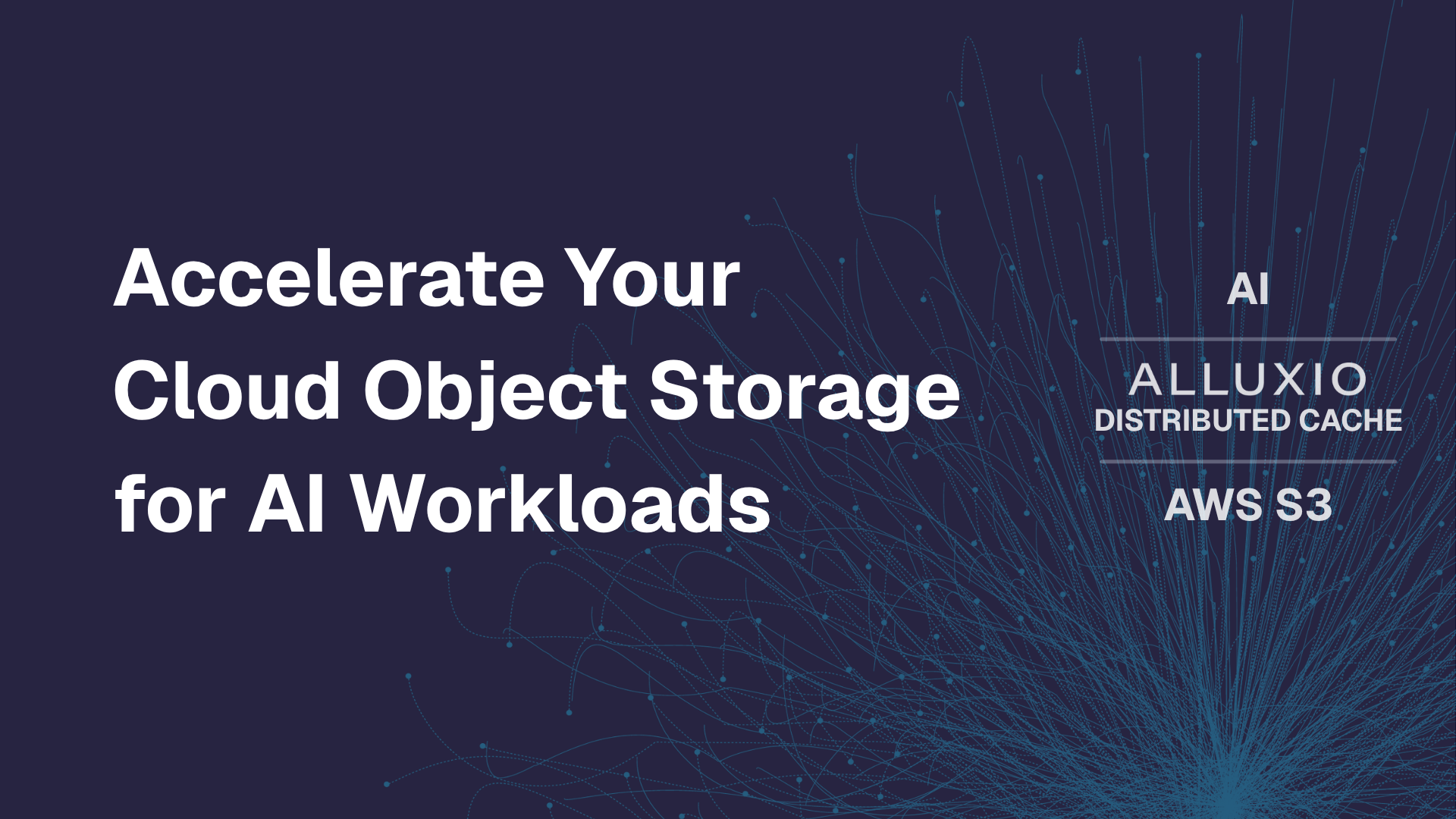Products
Blog

Alluxio and Oracle Cloud Infrastructure: Delivering Sub-Millisecond Latency for AI Workloads
Oracle Cloud Infrastructure has published a technical solution blog demonstrating how Alluxio on Oracle Cloud Infrastructure (OCI) delivers exceptional performance for AI and machine learning workloads, achieving sub-millisecond average latency, near-linear scalability, and over 90% GPU utilization across 350 accelerators.

Make Multi-GPU Cloud AI a Reality
If you’re building large-scale AI, you’re already multi-cloud by choice (to avoid lock-in) or by necessity (to access scarce GPU capacity). Teams frequently chase capacity bursts, “we need 1,000 GPUs for eight weeks,” across whichever regions or providers can deliver. What slows you down isn’t GPUs, it’s data. Simply accessing the data needed to train, deploy, and serve AI models at the speed and scale required – wherever AI workloads and GPUs are deployed – is in fact not simple at all. In this article, learn how Alluxio brings Simplicity, Speed, and Scale to Multi-GPU Cloud deployments.
.png)
Thank you! Your submission has been received!
Oops! Something went wrong while submitting the form.
.jpeg)
Alluxio Developer Tip: Why am I seeing the error User yarn is not configured for any impersonation impersonationUser foo
Impersonation is simply the ability for one user to act on behalf of another user. For example, say user ‘yarn’ has the credentials to connect to a service, but user ‘foo’ does not. Therefore, user ‘foo’ would never be able to access the service. However, user ‘yarn’ can access the service and impersonate (act on behalf of) user ‘foo’, allowing access to user ‘foo’. Therefore, impersonation enables one user to access a service on behalf of another user. The impersonation feature defines how users can act on behalf of other users. Therefore, it is important to know who the users are.
No items found.
.jpeg)
Testing Distributed Systems at 1000 node Scale for the Cost of a Large Pizza and yes on AWS
Testing distributed systems at scale is typically a costly yet necessary process. At Alluxio we take testing very seriously as organizations across the world rely on our technology, therefore, a problem we want to solve is how to test at scale without breaking the bank. In this blog we are going to show how the maintainers of the Alluxio open source project build and test our system at scale cost-effectively using public cloud infrastructure. We test with the most popular frameworks, such as Spark and Hive, and pervasive storage systems, such as HDFS and S3. Using Amazon AWS EC2, we are able to test 1000+ worker clusters, at a cost of about $16 per hour.
No items found.
.jpeg)
Presto on Alluxio How Netease Games leveraged Alluxio to boost ad hoc SQL on HDFS
Netease Games is the operator for many popular online games in China like "World of Warcraft" and "Hearthstone". Netease Games also has developed quite a few popular games on its own such as "Fantasy Westward Journey 2", "Westward Journey 2", "World 3", "League of Immortals". The strong growth of the business drives the demand to build and maintain a data platform handling a massive amount of data and delivering insights promptly from the data. Given our data scale, it is very challenging to support high-performance ad-hoc queries to the data with results generated in a timely manner.
Large Scale Analytics Acceleration

Top 10 Tips for Making the Spark Alluxio Stack Blazing Fast
The Apache Spark + Alluxio stack is getting quite popular particularly for the unification of data access across S3 and HDFS. In addition, compute and storage are increasingly being separated causing larger latencies for queries. Alluxio is leveraged as compute-side virtual storage to improve performance. But to get the best performance, like any technology stack, you need to follow the best practices. This article provides the top 10 tips for performance tuning for real-world workloads when running Spark on Alluxio with data locality giving the most bang for the buck.
Large Scale Analytics Acceleration
.jpeg)
Deploying Big Data Workloads on Object Storage Without Performance Penalty
As the amount of data being collected and analyzed by Enterprises continues to grow unabated, more attention is being placed on managing the cost of storing the data relative to performance. Hadoop provides a scalable and fast way of storing and analyzing data, however, the cost of storing data in Hadoop is typically higher compared to alternative technologies like Object Stores.
Large Scale Analytics Acceleration
.jpeg)
Developer Tip Why Did My Job Fail with Error Message Class alluxiohadoopFileSystem not found
From time to time, a question pops up on the user mailing list referencing job failures with the error message "java.lang.ClassNotFoundException: Class alluxio.hadoop.FileSystem not found". This post explains the reason for the failure and the solution to the issue when it occurs. This error indicates the Alluxio client is not available at runtime. This causes an exception when the job tries to access the Alluxio filesystem but fails to find the implementation of Alluxio client to connect to the service.
No items found.
.jpeg)
How To Speed Up Alluxio Metadata Operations Up To 100X
This blog describes our experience in speeding up Alluxio metadata operations using fingerprint and Alluxio under store bulk operations. These latest optimizations can be found in the 1.8.1 release. One of the major values Alluxio provides is a simple and unified interface to manage files and directories on different underlying storage systems. Alluxio acts as an intermediate layer and exposes a file interface for applications to interact with, even though the underlying storage system might be an object store that has a different interface.
No items found.

New York Meetup Recap: September 2018
we held our first New York City Alluxio Meetup! Work-Bench was very generous for hosting the Alluxio meetup in Manhattan. This was the first US Alluxio meetup outside of the Bay Area, so it was extremely exciting to get to meet Alluxio enthusiasts on the east coast! The meetup focused on users of Alluxio with different applications from Hive and Presto. As an introduction, Haoyuan Li (creator and founder of Alluxio) and Bin Fan (founding engineer of Alluxio) gave an overview of Alluxio and the new features and enhancements of the new v1.8.0 release.
No items found.

A Better Big Data Ecosystem with Hadoop and Hitachi Content Platform Part1
This blog explores the challenges customers are facing with storing data long term in Hadoop, and discusses what the Hitachi Content Platform team is doing to help our customers solve these challenges with the help of Alluxio. Data is at the center of our digital world and for years Hadoop has been the go-to data processing platform because it is fast and scalable. While Hadoop has solved the data storage and processing problem for the last ~10 years, it achieves this by scaling storage and compute capacity in parallel. As a result, Hadoop environments have continued to expand compute capacity well beyond their needs as more and more of the storage is consumed by older, inactive data.
Cloud Cost Savings
.jpeg)
Effective caching for Spark RDDs with Alluxio
Recently, Qunar deployed Alluxio with Spark in production and found that Alluxio enables Spark streaming jobs to run 15x to 300x faster. In their case study, they described how Alluxio improved their system architecture, and mentioned that some existing Spark jobs would slow down or would never finish because they would run out of memory. After using Alluxio, those jobs were able to finish, because the data could be stored in Alluxio, instead of within Spark. In this blog, we show by saving RDDs in Alluxio, Alluxio can keep larger data sets in-memory for faster Spark applications, as well as enable sharing of RDDs across separate Spark applications.
Large Scale Analytics Acceleration
.jpeg)
Starburst Presto Alluxio Better Together for Presto Caching
Presto was designed from the ground up to offer interactive analytics using a massively parallel processing SQL engine that can combine data from multiple sources using a variety of connectors. As more and more companies discover the power of “separation of storage and compute” along with querying the data where it lies, it’s not wonder Presto is being asked to add even more functionality. Alluxio focuses its innovation at the data layer as a key enabling technology for Presto and a wide range of analytics applications and use cases. Performance is always critical, but providing memory speed response time is only part of the solution. If the application can’t access the data, it’s of no use.
Large Scale Analytics Acceleration
Your selections don't match any items.


